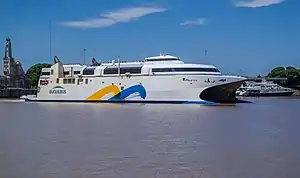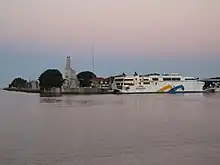 Francisco in Buenos Aires | |
| History | |
|---|---|
| Name | HSC Francisco |
| Namesake | Pope Francis, first Argentine Pope |
| Owner | 2013-present : Buquebus |
| Route | Buenos Aires—Montevideo |
| Builder | Incat, Hobart, Tasmania |
| Yard number | 69 |
| Launched | 17 November 2012 |
| In service | 2013 |
| Homeport | Montevideo, Uruguay |
| Identification |
|
| Status | In service |
| General characteristics | |
| Tonnage | 7,109 GT; Summer DWT: 500 t |
| Length | 99 m |
| Beam | 26.48 m |
| Installed power | 6 Caterpillar C18 generators for onboard power + 2 Caterpillar C9 generators for main engine services |
| Propulsion | 2 General Electric LM2500 rated at 22 MW each[1] driving 2 Wärtsilä LJX1720 SR Waterjets |
| Speed | 58 knots (67 mph; 107 km/h) |
| Capacity |
|
HSC Francisco is a high-speed catamaran built by Incat in Hobart, Tasmania. Powered by liquefied natural gas,[3] she is currently the fastest passenger ship in service, reaching a speed of 58 knots (107 km/h; 67 mph). Propulsion is by two GE LM2500 gas turbines, coupled with two Wärtsilä water-jets.
The catamaran is owned and operated by Argentine-Uruguayan ferry company Buquebus. Francisco plies the 146-nautical-mile (270 km; 168 mi) sea route between Buenos Aires and Montevideo.[4]

Francisco in Buenos Aires
HSC Francisco is named after Pope Francis.
See also
Wikimedia Commons has media related to IMO 9610028.
References
- ↑ "069".
- ↑ Thakkar, Pooja (1 July 2013). "The Fastest Ship on Earth Powered By Jet Engines". Technology Digital. San Diego. Archived from the original on 13 July 2014. Retrieved 2 June 2015.
- ↑ Rebón, Nuria (26 April 2018). "Buquebus: u$s 190 millones para una nueva terminal, energía solar y barco a GNL". El Cronista (in Spanish).
- ↑ Sea routes
This article is issued from Wikipedia. The text is licensed under Creative Commons - Attribution - Sharealike. Additional terms may apply for the media files.